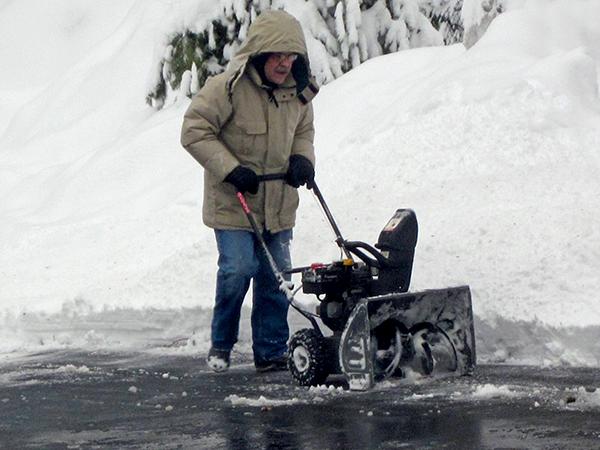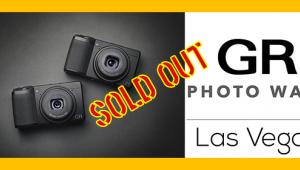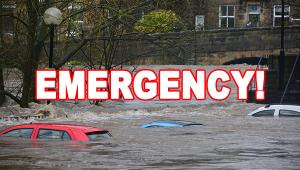Be Prepared: 7 Essentials For Managing Photo-Related Emergencies
Remember Albert? Not Einstein—I mean the Albert that’s also known as “Snowtober.” If you lived on the East Coast in October 2011 you remember Albert as the freak Halloween snowstorm that left more than three million homes and businesses without power. Talk about Trick or Treat. One thing that we all should have learned from that painful experience is what all Boy Scouts know: Be Prepared.
My area was not hit particularly hard by the October 2011 Frankenstorm, but my home was without electricity for eleven (count them—eleven) days. Fortunately our natural gas supply was not interrupted, so we had heat, hot water and the ability to cook. I was able to recharge our phones and tablets daily so we had unimpeded communication and entertainment. In other words, it could have been a lot worse. In fact, with secure shelter, heat and fresh running water we had it better than many families have it on their best days.
Natural disasters can be divided into two broad categories: those that make you leave your home, and those that allow you to stay but force you to hunker down. Major hurricanes fall into the first bucket, and snowstorms into the second. The items described below are more useful when you’re on the run, but all are good to own even if you never face an emergency situation.
 1. Grab and Go External Hard Drive
1. Grab and Go External Hard Drive
A good computer file backup regimen requires redundancy upon redundancy. Add disaster protection by keeping one copy of every important file on an external hard drive that can be quickly disconnected and rescued if you’re forced to flee the scene. The best I’ve found are the LaCie Rugged Series which come in capacities up to 4TB at reasonable prices and are drop and shock resistant, available in virtually all flavors of Thunderbolt, USB-C, etc., and are quite compact. The 2TB Mini, for instance, measures only 3.4 x 5.3 x 0.75 inches, a footprint scarcely larger than a 3x5 index card. They are also clothed in a resilient, safety orange cover that makes them easy to find when it’s time to boogie.
 2. Bug Out Bag
2. Bug Out Bag
Once thought of only in connection with radical doomsday preppers, a Bug Out Bag is simply a backpack or sling that contains things you’ll be glad you packed if the snot hits the fan. Pack the obvious: medicine needed by you and family members, extra camera battery and memory cards, flashlight, candles, knife, first aid kit and an extra pair of glasses. Exact contents varies with the individual; think camping trip and you’ll quickly come up with an inventory. For a container, I use an aptly-named SOG Evac Sling 18. It’s relatively small (19.7 x 13.4 x 7.9 inches) but holds a laptop or large tablet and everything I need to thrive in the wilderness. It’s highly water resistant, very well made and nicely organized. It uses the popular military MOLLE system to attach additional pouches or bags and—for those readers who live in hotter climates—will accommodate a hydration bladder in place of the laptop computer.
3. Power to Spare
They call them Power Banks but you’ll call them miraculous if your cell phone or camera dies while you’re home is without electricity. In essence they are just big rechargeable batteries that are designed to store a large capacity of juice until you need it. Equipped with USB ports, these babies will throw a charge into your phone or tablet and keep you connected for hours beyond normal cell phone battery life. Most are rectangular, but that’s where the similarity ends. Look for a unit that has a large mAh (milliamp hour) rating, 10,000 minimum. Cells with Lithium Poly chemistry are safer than Lithium Ion. Some models accept power input from alternative sources like solar panels—that can be handy. Avoid unfamiliar brands and stick with names you believe you can count on. And above all else, remember to keep it charged.
4. UPS (Uninterruptable Power Supply)
If you have a laptop computer with a built-in battery, you’re ahead of the game when the lights go out because you can still work for somewhere between one and 10 hours, depending on the brand of PC you drive. But if you use a desktop, everything suddenly stops—whether you’ve saved your work or not—when something cuts the juice. A UPS, or Uninterruptable Power Supply, sits like a cat ready to pounce the instant it senses that your computer is no longer being fed from the main current. Some UPS units allow you to work for a long period of time, and some barely give you enough time to hit Control-S to save and then safely power down. Keep in mind that the batteries inside a UPS do not last forever; their storage capacity declines with age. So it’s advisable to stop working shortly after the UPS takes over and—even more important—remember to replace the unit (or just the battery if possible) as per the manufacture’s recommendations.

5. Weather Radio
The NOAA Weather Radio system continuously transmits local and regional weather information. This is a great resource when things are good, and it becomes a priceless source of accurate, up to the minute info during disasters. They use a set of frequencies clustered around 162.500 MHz. The exact frequency for your area can be found on their website. Since regular AM-FM radios cannot be tuned to this range, you need a weather radio or police scanner. NOAA transmits an emergency tone that wakes up some specially equipped radios, so if you live in a tornado prone area, consider a receiver that offers this feature. Some models, like the Midland Weather Alert crank radio ($49) offers AM, FM and NOAA weather broadcasts, a built-in LED flashlight, USB charger output, hand crank and solar panel. You can be battery-free and still charge your phone. The Midland unit is small (7.5 x 5.25 x 2 inches) and weighs one pound.
6. M&Ms, MREs
Everyone knows what M&Ms are. They’re short on nutrition but long on keeping kids quiet during a weather blackout. They’re also a good source of energy. MRE is the abbreviation for Meals Ready-to-eat, the portable chow issued by our military units. Currently there are about 24 menu variations available, and all complete meals include a Flameless Ration Heater. They’re available for $12 to $18 online from various sources and typically contain an entree, side dish, bread product, dessert, candy and one or more beverage mixes. If you intend to keep a few of these around for an emergency, it’s a good idea to open and sample one beforehand. The chemical heater is easy to use but it gets scalding hot and could possibly injure a child or unwary adult. These are surplus, of course, and could be old, so you should check the inspection dates carefully. Finally, many MREs contain M&Ms—so there is a method to my madness.
7. Paracord
“Paracord” is a shortened name for parachute cord. Think of it as thin, extremely strong rope. There are a few variations, but the most common cord consists of a nylon sleeve that has seven individual strands inside. As you can imagine, paracord has hundreds of uses, everything from an emergency camera strap, dog leash, shelter lashing, shoelace, belt – the list is endless. The smaller internal strands can be plucked out and used as sewing thread, fishing line, cheese slicer, etc. It’s available in what seems like a zillion colors and is often used to make knife lanyards and bracelets. The bracelets are worn as a convenient way to keep a few yards of material literally at hand, ready to be unraveled when needed. Beginners should try 550 Paracord, so named because it has break-strength rating of 550 lbs.
—Jon Sienkiewicz
- Log in or register to post comments


















































